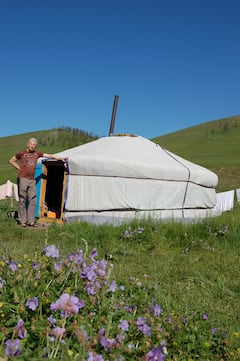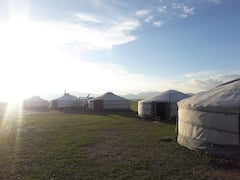Travelers from all over the world are lured by the numerous things to do in Mongolia, its jagged mountain peaks, shimmering glacial lakes, sprawling steppes, and cerulean sky. However, apart from its beguiling natural beauty, the land holds immense religious significance for the seekers of divinity. Buddhism has played a vital role in casting the cultural heritage of this country. A number of monasteries were built in the country over the times, which now hold a special part in the identity of the nation. These monasteries, the symbols of the country’s religious and cultural heritage, are a sanctum of divine grace for the people who come in search of spiritual bliss and tranquillity over here. Located in picturesque settings on the top of mountains, they greet visitors with the mystical fragrance of incense and the rhythmic chantings of monks, that immediately transport the soul to the realm of divinity. From awe-inspiring architectural beauty to a peaceful environment and ancient legacies, these monasteries are the perfect places to cut away from the grind of daily life. Keep reading to have a look at the best monasteries in Mongolia.
Zayiin Gegeen Monastery
These are notes and references from the research team. Kindly remove them from the paragraph before submitting your draft:
Reference: http://www.touristinfocenter.mn/en/cate1_more.aspx?ItemID=73
Zayiin Gegeen Monastery
Address: 601, Pearl tower, 3rd Khoroo, Chingeltei District, Ulaanbaatar, Mongolia
Website: Zayiin Gegeen Monastery
1. Khamba Monastery
Editor's Note: There's no photo available at the time of writing
Perched at the foot of the holy Khögnö Khan Mountain lies the most sacred monastery, the Khamba Monastery. Created by a devoted student under His Holiness Erdene Budaq. As a homage to this lama who was such a great source of spiritual teaching and spiritual guidance, this monastery stands there.
If you are looking for an active monastery with lots of resident monks then this is not the place for you but it does remain an important place for religious or cultural purposes. Periodically — once or twice a month — local lamas come together for religious rites. These events serve as an important vessel for maintaining and passing on these traditions, offering devoted followers a place to gather, pray, sing chants and practice rituals according to their religious beliefs.
Khamba Monastery
Address: Erdene Khamb Monastery, Bulgan province, Mongolia
Website: Khamba Monastery
2. Dashchoilin Monastery
Editor's Note: Photo taken from the establishment's official social account
Жил бүр уламжлал болгон зохион байгуулдаг "Эдийн бумба" тахих тахилгын хурал 2023 "ЭДИЙН БУМБА"-ЫГ ШҮТЭХ, ТАХИХ ТУХАЙ. ...
Posted by Зүүн Хүрээ Дашчойлин хийд on Sunday, September 10, 2023
The Dashchoilin Monastery is an important Buddhist monastery famous for its cultural and educational achievements. There are about 100 monks residing on the premises and a very active spiritual community committed to practicing Buddhism. In addition to its prayer halls, the monastery functions as a university offering courses on religious studies and social sciences, teaching religion and Buddhism to monks, nuns and other people wishing to learn about these teachings.
Furthermore, the Dashchoilin Monastery is an educational centre for the study of Buddhist culture where extensive research and scholarship take place. Here folks can dive into the details of Buddhist traditions, history & philosophies.
At the top of the institution lies a doublet that takes charge of conducting conferences, finalizing resolutions and general management of the Dashchoilin Monastery.
Dashchoilin Monastery
Address: 48 Sodnom St., Academician, 8th district
Website: Dashchoilin Monastery
You might be interested in these Airbnbs!
3. Gantegchilen Monastery

Gantegchilen Monastery is one of the most popular Tibetan Buddhist monasteries in Mongolia and is revered by tourists for its striking architecture and serene environment. The Tibetan name has the meaning, “the great place of complete joy.“ Among the notable attractions of this monastery, there is 26.5 meters (85 feet) high statue of Avalokitesvara, the Buddhist sage who shows the path of truth. It is famous as the tallest indoor statue in the world and is made of copper gilded with gold, and embellished with sparkling precious stones. You will need to acquire a permit to take photos in certain areas of the temple.
Gantegchilen Monastery
Address: 16 Khoroo, Bayangol District, Ulaanbaatar, Mongolia. ZIP 16040
Website: Gantegchilen Monastery
4. Aryaval Monastery / Aryaval Meditation Center
Did you know that Aryaval Monastery was built in the shape of an elephant's head? There are 108 stairs leading to the...
Posted by MNB World on Wednesday, 29 May 2019
The meditation center was built in the unique shape of the head of an elephant. It was opened in 2006 and is known for its marvelous architecture and breathtaking interiors that exhibit a thangka depicting the mythical Shambhala and a Kalachakra Mandala. It offers an enthralling view of the surrounding granite formations, rolling valleys and a river meandering through the lush greeneries. There are more than one hundred and eight stairs that lead to the temple, and you can find here the Buddhist monks of Mongolia as well as the visitors meditating to attain tranquillity and peace.
Aryaval Monastery / Aryaval Meditation Center
Address: Gorkhi-Terelj National Park , Peace Avenue 206, Ulaanbaatar, Mongolia
5. Ongi Monastery

Located in the beautiful province of Dundgovi, this was one of the largest Buddhist monasteries in ancient Mongolia. The monastery was founded in the year 1660 and comprises two temple complexes on either side of the Ong river. Barlim on the north bank was constructed during the 18th century and consisted of 17 temples, one of which was famous as the largest one in Mongolia. The 1930 socialism wave brought destruction to this monastery. Today, the ruins still reverberate with a spiritual energy that is bound to tantalize. One of the curiosities of this place is a cold water source, named Bar Khamba, which supposedly restores digestive health when you drink it before sunrise.
Ongi Monastery
Address: Saikhan-Ovoo, Mongolia
6. Khamar Monastery

Founded in 1820 by a young Buddhist monk, Danzanravjaa, Khamar Monastery was a renowned educational and cultural center of the “red sect” of Buddhism in Mongolia. It was the home to around 500 monks and around 80temples were located at this site. The uniqueness of this temple was that women were offered more respect and importance than men at this place, which was unusual at that age. This sanctum of divinity and spiritual bliss was destroyed in 1937, but now it is gradually being restored to its former glory. It is believed that people can absorb the spiritual energy of the area and recover from ill-health at the sacred Khoid Shambala, or paradise of the north, located here.
Khamar Monastery
Address: Khatanbulag district, Dornogovi Province
Website: Khamar Monastery
7. Shankh Monastery
Posted by Gaetano La Rocca on Friday, 16 August 2019
This is among the ancient monasteries of Mongolia, located in the southeastern region of Kharkhorin. It was founded by Zanabazar in 1648 and is touted to be the only monastery that has survived the 1937 purge. The monastery belongs to the school of Tibetan Buddhism, the “yellow hat” sect. At one time, more than 1500 Buddhist monks resided here and practiced tantric rituals. A present, the monastery has three temples that preserve the clothes and the creations of the founder Zanabazar, the celebrated spiritual leader of Buddhism. The main temple of the monastery is renowned for its seven Kalachakra Mandalas that portray around 722 Kalachakra deities.
Shankh Monastery
Address: Shankh Monastery, Kharkhorin, Mongolia
Website: Shankh Monastery
8. Tövkhön Monastery

This ancient monastery was founded by Zanabazar, and he worked and meditated here for around thirty years. Nestled in the middle of dense pine forests, the monastery has emerged as one of the most popular pilgrimage sites for the Mongolians. It was destroyed in 1937 but was rebuilt in the 1990s. The monastery is located on the top of a rocky outcrop that resembles a throne in its formation. Around seven to eight monks live here all round the year and follow Buddhist spirituality. There are several temples in and around this place, and one is reputed as the site of a footprint of Zanabazar.
Ulaanbaatar to Orkhan Valley and Tuvkhun Temple 3-Day Tour
Duration: 3 days
9. Baldan Bereeven Monastery

Established in 1654 and located in Jargalant valley backed by the steep cliff of Munkh Ulziit mountain, this was the second biggest monastery in ancient Mongolia. Over 5000 monks resided here. Unfortunately, the communist regime destroyed the place and the monastery was about to fade into oblivion. However, today it has been restored and houses around three temples and fifty remains of stupas, with other significant religious structures. More than 10 monks actively practice Buddhism here and the monastery is gradually growing in popularity.
Baldan Bereeven Monastery
Address: Baruun Jargalant River valley Ömnödelger district, Khentii Province, Mongolia
Website: Baldan Bereeven Monastery
10. Amarbayasgalant Monastery (from USD 117.0)

Popularly known as the “Monastery of Tranquil Felicity,” it is one of the largest monasteries in Mongolia. It was commissioned by Emperor Yongzheng and the construction was completed between 1727 AD to 1737 AD. The monastery was built as the resting place of Zanabazar, the foremost Buddhist spiritual leader in the country. It is located near the Selenge valley and is visited by a huge number of tourists every year. The monastery houses several crucial scripts of cultural heritage, such as two hundred and twenty-six volumes of Danjuur and one hundred eight volumes of Ganjuur, that bear inscriptions about ancient philosophy, geography, science, medicine, art, music, and astronomy. A famous stupa, known as “Jarun Hashor” or “eye stupa”, is located close to the monastery, and it is believed that whosoever looks at the eye of the stupa are absolved of all sins.
Amarbaysgalant Monastery and National Reverse Park Tour
Duration: 10 to 12 hours
11. Erdene Zuu Monastery (from USD 117.0)

One of the earliest Buddhist monasteries in Mongolia, it was built on the ancient ruins of Khar Khorin city by Avtai Sain Khan. It is a part of the UNESCO World Heritage sites. The monastery was closed till 1965, and it was permitted to reopen again as a museum to showcase the rich history of Mongolia. The temples of this monastery were destroyed during the Stalinist purges, and the monks who resided here were either sent to gulags in Siberia or were massacred. Fortunately, many statues, thangkas, and tsam masks were saved. Now it has become an important tourist attraction and acts as a great repository of religious artifacts and sculptures. You can view the biggest stupa in Mongolia, the “Golden Stupa”, and different images of Buddha, in his past, present and future forms, in this monastery.
Erdene Zuu Monastery and Kharkhorin Tour from Ulaanbaatar
Duration: 1 day
12. Mañjuśrī Monastery (from USD 152.0)

Mañjuśrī Monastery, established in 1733, was ruined by the communists in 1937. In its heyday, it housed twenty temples and was home to around three hundred monks who were executed in the late 1930s. The main temple was rebuilt after 1990 and was turned into a museum. You can still see the ruins of the seventeen buildings which were earlier located at this place. The Togchin temple, which was originally built in 1749, though in ruins, still reflects the glory of Tibetan architecture. You can view several Buddhist cave paintings and inscriptions dating back to the 18th century in a cliff located above the monastery.
Ulaanbaatar to Manzushir Monastery Horse Riding Tour and Lunch
Duration: 6 to 8 hours
Visit Mongolia and revive your connection with the divine
The monasteries in Mongolia are not only places of great religious significance, but they also bear testimony to some of the notorious struggles of the people of the nation. Once completely destroyed, they now stand as the symbols of how life and hope always reassert over vandalism. Some of these Mongolian Buddhist temples are extremely rich in ancient Buddhist arts. Book one of the best authentic yurts in Mongolia, and experience the energy of ancient spirituality.
Frequently asked questions about monasteries in Mongolia
History
Get Trip101 in your inbox
Unsubscribe in one click. See our Privacy Policy for more information on how we use your data
























Create an account to